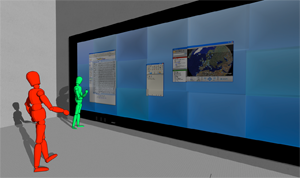A Comparison of Ray Pointing Techniques for Very Large Displays

Pointing at a distance is becoming one of the most important ways to interact with interactive systems. In this project we aim at understanding the different ways of pointing and the different factors that affect performance in pointing to different surfaces (mostly very large displays). So far we have found that, on large displays, rotational ray-pointing is better for targeting tasks, but for tracing (or steering) the most important factor is the lack of parallax between eye and pointing tool. Our results also indicate that large-display targeting tasks should be modeled by using angular models (e.g., an angular adaptation of Fitts' law) rather than linear models.
Researchers
Ricardo Jota
Miguel A. Nacenta (PostDoc)
Joaquim Jorge (Project Advisor)
Saul Greenberg (Supervisor)
Sheelagh Carpendale (Project Advisor)


 ucalgary.ca
ucalgary.ca